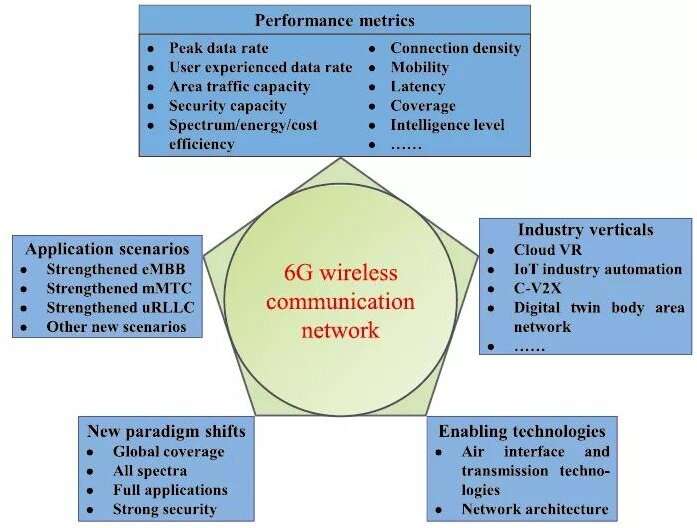An overview of 6G wireless communication networks Credit: ©Science China Press
Fifth generation (5G) wireless communication networks are being deployed worldwide from 2020 and more capabilities are in the process of being standardized, such as mass connectivity, ultra-reliability, and guaranteed low latency. However, 5G will not meet all requirements of the future in 2030 and beyond, and sixth generation (6G) wireless communication networks are expected to provide global coverage, enhanced spectral/energy/cost efficiency, better intelligence level and security, etc. To meet these requirements, 6G networks will rely on new enabling technologies, i.e., air interface and transmission technologies and novel network architecture, such as waveform design, multiple access, channel coding schemes, multi-antenna technologies, network slicing, cell-free architecture, and cloud/fog/edge computing.
A long-form review, titled "Towards 6G wireless communication networks: vision, enabling technologies, and new paradigm shifts," was published in SCIENCE CHINA Information Sciences. It is co-authored by Prof. Xiaohu You (first and corresponding author) and Prof. Chengxiang Wang (corresponding author) from Southeast University, China, along with other 48 experts and scholars from scientific research institutes, colleges, and companies both at home and abroad.
In this article, the vision on 6G is that it will have four new paradigm shifts. First, to satisfy the requirement of global coverage, 6G will not be limited to terrestrial communication networks, which will need to be complemented with non-terrestrial networks such as satellite and unmanned aerial vehicle (UAV) communication networks, thus achieving a space-air-ground-sea integrated communication network. Second, all spectra will be fully explored to further increase data rates and connection density, including the sub-6 GHz, millimeter wave (mmWave), terahertz (THz), and optical frequency bands. Third, facing the big datasets generated by the use of extremely heterogeneous networks, diverse communication scenarios, large numbers of antennas, wide bandwidths, and new service requirements, 6G networks will enable a new range of smart applications with the aid of artificial intelligence (AI) and big data technologies. Fourth, network security will have to be strengthened when developing 6G networks.
This article provides a comprehensive survey of recent advances and future trends in these four aspects. Clearly, 6G with additional technical requirements beyond those of 5G will enable faster and further communications to the extent that the boundary between physical and cyber worlds disappears.
More information: You X H, Wang C-X, Huang J, et al. Towards 6G wireless communication networks: vision, enabling technologies, and new paradigm shifts. Sci China Inf Sci, 2021, 64(1): 110301, doi.org/10.1007/s11432-020-2955-6
Provided by Science China Press
























